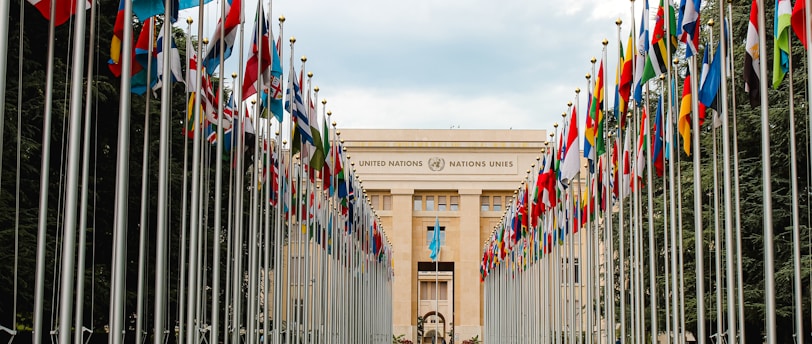One Convention to Rule Them All? Why a Crimes Against Humanity Treaty Could Transform Mass Atrocity Prevention and Improve Accountability
Mike Brand
7/16/2025


Mass atrocities–war crimes, crimes against humanity, genocide, and ethnic cleansing–are some of the greatest threats to human security. Systematic targeting of civilians, identity-based violence, indiscriminate bombing, and using food as a weapon of war to starve populations are causing unimaginable suffering to populations across the world. Instead of preventing violence or mustering effective responses once violence breaks out, time and time again, we see policymakers, journalists, academics, and activists caught in definitional debates over how to describe the horrors while people continue to be killed.
These debates often focus on whether a situation meets the strict definition of genocide–intent to destroy an ethnic, national, racial, or religious group in whole or in part–as if crimes against humanity or war crimes are somehow less severe or less deserving of attention. This false hierarchy of atrocity crimes plays out in several ways. Universities, NGOs, and think tanks will often separate genocide from other atrocity crimes, depicted as ‘genocide and mass atrocities’ even though genocide is a mass atrocity. Governments and intergovernmental organizations more freely label a situation or state that perpetrators have committed war crimes or crimes against humanity, but will exert much more scrutiny before labeling something genocide. We’ve also seen the term genocide used by activists and politicians for political purposes to try and attract attention to a situation, even if the term is not accurately applied. News organizations also seem fixated on whether something is labeled genocide or not, often spending more time covering the debates and controversy surrounding the use of the term genocide rather than covering the crimes being committed, regardless of what they are called.
The false hierarchy of atrocity crimes and myopic/sensational focus on genocide continues to reinforce this flawed understanding of the severity of these crimes. Further, these definitional debates often lead to analysis paralysis, preventing effective policy decisions while civilians continue to suffer.
There may be a way out of this cycle if the United Nations adopts a new Convention on the Prevention and Punishment of Crimes Against Humanity (crimes against humanity convention). If adopted, the treaty would close a nearly 80-year gap in international law and potentially improve mass atrocity prevention, response, and accountability, thereby saving lives and combating impunity.
A Brief History of Codifying Atrocity Crimes
In the aftermath of World War II and the Holocaust, the Allied powers came together and signed the London Agreement on August 8, 1945. This agreement established the International Military Tribunal, more commonly known as the Nuremberg Trials, to hold Nazi leaders accountable for their crimes. The courts at Nuremberg had the jurisdiction to prosecute individuals for crimes against peace (essentially the crime of waging international war), war crimes (violations of the laws and customs of war), and crimes against humanity (crimes perpetrated against civilian populations). The International Military Tribunal for the Far East, otherwise known as the Tokyo War Crimes Trials, was modeled after Nuremberg and sought to hold senior Japanese leaders accountable for crimes committed during WWII. Similar to Nuremberg, the Tokyo Trials also had jurisdiction over crimes against peace, war crimes, and crimes against humanity.
At the time, only war crimes had previously been codified in subsequent Geneva Conventions in 1864, 1906, and 1929. The Geneva Conventions were updated again in 1949 after WWII. The inclusion of crimes against humanity at Nuremberg marked an important milestone in international legal jurisprudence, establishing that individuals could be held responsible for crimes committed against civilian populations at times of war and times of peace, as opposed to war crimes, which only occur during war.
Largely in response to the horrors of the Holocaust, in 1948 the newly created United Nations adopted the first piece of international human rights law, the Convention on the Prevention and Punishment of the Crime of Genocide (genocide convention). After a Herculean lobbying effort by Raphael Lemkin, who first coined the term genocide, ensuring every member state had a reason to support the convention, the UN unanimously adopted the treaty. The convention existed not only to outlaw genocide but to ensure efforts would be undertaken to prevent future genocides from happening. What Raphael Lemkin fought for and what eventually made it into the final text of the genocide convention is a topic for another post.
Despite crimes against humanity being one of the core crimes outlined during the Nuremberg and Tokyo Trials, an international treaty that codifies state responsibility to prevent, prosecute, and punish these crimes was never established.
International jurisprudence on crimes against humanity continued to be developed in the aftermath of the mass atrocities in the 1990s in Rwanda and the former Yugoslavia. The International Criminal Tribunal for the former Yugoslavia (ICTY) and the International Criminal Tribunal for Rwanda (ICTR) both had jurisdiction over war crimes, crimes against humanity, and genocide.
In 1998, fifty years after the genocide convention was adopted, the Rome Statute, which established the International Criminal Court (ICC), was adopted. One of the crimes under the jurisdiction of the ICC was crimes against humanity. Despite not having an international treaty to draw on for reference, the Rome Statute defined crimes against humanity as “widespread or systematic attack directed against any civilian population, with knowledge of the attack.” The Rome Statute outlined several specific acts which would constitute crimes against humanity, including murder, extermination, forcible transfer of a population, apartheid, persecution against any identifiable group, rape and sexual violence, etc.
While the Rome Statute defines crimes against humanity, it only applies in the context of the jurisdiction of the ICC, individual accountability, and punishment after crimes have been committed. A convention to specifically codify crimes against humanity would not only establish an international legal definition of the crime. It would also establish state responsibility to prevent and punish the crime, including expanding domestic law and universal jurisdiction to either hold individuals accountable or extradite an alleged offender to another state or international tribunal for prosecution. Additionally, the crimes against humanity convention would establish the opportunity for states to hold other states accountable for violating the convention at the International Court of Justice.
The Road Not Taken
Much of the contemporary debate surrounding the hierarchy of atrocity crimes, placing genocide above other international crimes and often labeling it as the “crime of crimes,” stems from the post-Holocaust post-World War II focus on codifying genocide.
Imagine if the international community, in 1948, had adopted a comprehensive convention addressing crimes against humanity, either in conjunction with or instead of the genocide convention? Had such a convention been introduced, our contemporary understanding of crimes against humanity might be different, and we might avoid the problematic notion that genocide inherently warrants greater international attention and is more severe. Conversely, if UN member states had prioritized the codification of crimes against humanity over genocide, a genocide convention might never have been established.
While genocide is unique in that perpetrators intend to destroy an ethnic, national, racial, or religious group in whole or in part, the violence perpetrated during genocide also constitutes crimes against humanity. The main difference between the two crimes is that crimes against humanity can be perpetrated against any civilian population, with or without the intent to destroy the population. While genocide can only occur against specific targeted groups, and the perpetrator’s intent to destroy the population, in whole or in part, must be present. Essentially, all genocides are crimes against humanity, but not all crimes against humanity are genocide.
The intent to destroy a specific group is heinous, but the fact remains that if one of those protected groups is not specifically targeted, or intent to destroy cannot be proven, it does not mean that the crimes perpetrated are any less severe against a civilian population. Take, for example, the civil war in Syria. Large-scale war crimes and crimes against humanity were committed against the civilian population for over a decade, resulting in hundreds of thousands of civilians killed, millions displaced, and countless civilians tortured and disappeared.
The Path Ahead and Recommendations
Late last year, the United Nations General Assembly’s Sixth Committee took the long-overdue step to advance toward the negotiation of a crimes against humanity convention. The process has been several years in the making, but the process is finally moving forward. However, the bureaucratic wheels of the UN move slowly, and the new convention will likely not be voted on before 2029 at the earliest.
Once the convention is adopted and goes into force, will we move away from segregating the different atrocity crimes? Will everything become crimes against humanity? Should it? It’s possible from the perspective of accountability that prosecutors will default to charging perpetrators with crimes against humanity instead of genocide, as there is a much lower burden of proof. Will we move away from the term mass atrocities and embrace crimes against humanity as the focal point? Time will tell. In the meantime, there is plenty of work that can be done.
Make the Treaty Language the Best It Can Be
When the genocide convention was drafted, much of the world did not have a say in the drafting of the convention. The drafting of the final text of the crimes against humanity convention is a unique opportunity to influence what should be a major piece of international human rights law.
Over the next four years, states will continue negotiations and offer amendments to the draft treaty language. Civil society and nongovernmental organizations should take this opportunity to press for changes and expansions to the treaty at capitals around the world and at the UN. As an example, one issue that is gaining traction both among advocates and governments is that of gender apartheid. Experts and activists point to the discrimination, oppression, and segregation along gender lines in Afghanistan as a prime example of why the definition of apartheid must be expanded beyond race to include gender.
Stop Feeding Into the False Hierarchy of Atrocity Crimes
Academic institutions, think tanks, practitioners, and journalists should make an effort not to feed into the false hierarchy of atrocity crimes. This includes renaming departments, courses, publications, etc., moving away from phrases like ‘genocide studies’ or ‘genocide and mass atrocities’ and instead simply ‘mass atrocities.’ Several prominent and well-respected institutions and individuals are guilty of this. We all need to make a conscious effort to shift our terminology and emphasize the severity of all atrocity crimes.
Invest More in Prevention and Break Down Silos
The failure to adequately invest in upstream prevention results in the international community constantly reacting instead of proactively addressing root causes and warning signs before violence breaks out. The international community has proven to be ineffective at responding to end mass atrocities, often employing a set of tools that have little evidence of success. More investment in structural prevention must be prioritized by intergovernmental institutions, national governments, donors, implementers, and civil society.
Many of the root causes, drivers, and warning signs of mass atrocities are shared across all atrocity crimes. Yet we continue to have separate departments, bureaus, organizations, and funding streams dedicated to addressing these issues individually. Collectively, we must streamline efforts across the currently disconnected fields of atrocity prevention, conflict prevention, counterrorism, countering violent extremism, peacebuilding, etc., and work toward addressing the underlying risk factors that will prevent violence and improve human security.
Mike Brand is the Founding Director of the Human Security Project. Mike is a human rights, atrocities prevention, and peacebuilding professional with nearly two decades of experience in policy, advocacy, organizing, and education. He is also an Adjunct Professor of mass atrocities prevention and human rights at Georgetown University and the University of Connecticut. You can follow Mike online at @miketheidealist everywhere and on LinkedIn.
Human Security Project
Delivering bold, actionable interventions to prevent violence, protect people, and build human security.
Connect
Engage
© 2025. All rights reserved.
